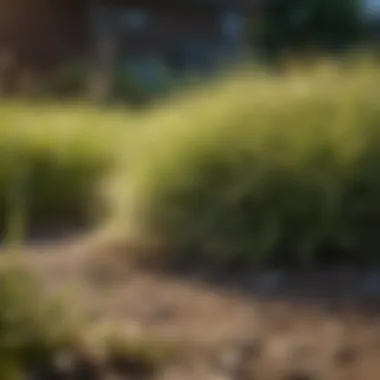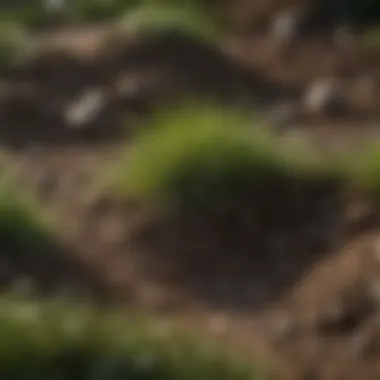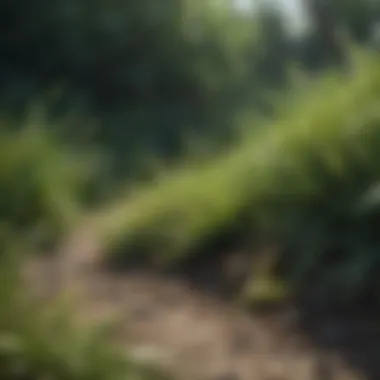Factors Influencing Rapid Grass Health Decline


Intro
Maintaining a lush green lawn can feel like walking a tightrope. One moment everything seems just right – the grass is vibrant, and the neighbors are peering over their fences with envy. Then, out of nowhere, it seems that all those efforts take a nosedive. Grass can decline for a myriad of reasons, and understanding these can be critical if you want to keep your lawn looking sharp.
As we peel back the layers, we’ll explore environmental stressors, chemical imbalances, and biological threats in detail. You may wonder, why does this matter? Well, knowledge is power. By grasping what accelerates grass decline, homeowners and gardening enthusiasts can take informed steps to counteract these issues.
From how sunlight, soil type, and moisture levels intertwine to impact grass health, to the infamous weeds that threaten your lawn's vibrancy, we’ll leave no stone unturned. This guide isn't just about keeping up appearances; it’s about fostering a strong, resilient lawn that can withstand the ebb and flow of Mother Nature’s whims.
Design Inspirations
While the term “design inspirations” might seem more fitting in the realm of interior decor, when it comes to landscaping, aesthetics play a major role too. One could argue that the inspiration behind your lawn's design can significantly impact its health.
Trending Styles
Gardening trends fluctuate like the stock market, with each season bringing forth new styles worth considering. Lately, there’s been a push towards sustainable landscaping. Homeowners are opting for native grass varieties that require less water, pesticides, and maintenance. This not only aligns with their eco-friendly aspirations but also bolsters resilience against local pests. Examples include fescue and bluegrass, both known for their durability and low upkeep.
Color Palettes
A great lawn isn’t just green; it can also bloom with brilliant colors through carefully chosen flower beds and ornamental grasses. For instance, incorporating purple coneflowers or daylilies can add striking contrast to the greens, making your yard more visually appealing while also encouraging beneficial insects.
Maintenance and Upkeep
If a well-kept garden is your goal, a consistent maintenance routine is essential. It’s easy to overlook little details amidst a busy life, but these nuances can either make or break the health of your grass.
Seasonal Maintenance Checklist
- Spring: Fertilize with a balanced blend and overseed if necessary. At this time, inspect for bare patches.
- Summer: Ensure adequate watering during dry spells. Never let your grass grow too long, as that can lead to diseases.
- Fall: Aerate your lawn to relieve compacted soil. Add a winterizing fertilizer to strengthen roots.
- Winter: Keep an eye on heavy snow accumulation which can suffocate grass.
Cleaning and Organization Tips
The tools of your trade matter, and their maintenance is equally important.
- Store your mower properly - Keep blades sharp to ensure clean cuts.
- Organize your gardening space to streamline tasks. This reduces the chance of missing out on vital upkeep when time is of the essence.
"A lawn that is closely attended spruces up a home, creating a welcoming atmosphere all year round."
In closing, understanding the factors that expedite grass decline not only helps you keep your lawn looking its best but empowers you with strategies that can significantly enhance its health. Armed with this knowledge, you’ll be ready to tackle those pesky issues head-on.
For more information on lawn care, consider exploring Wikipedia or Britannica. Join discussions with fellow enthusiasts on platforms like Reddit and connect with experts on Facebook.
Stay tuned for the deeper dive into the various elements affecting grass health!
Overview of Grass Health
Grass health serves as the foundation for vibrant landscapes, whether it's your backyard or a public park. Understanding the factors that influence grass health can lead to better management decisions, translating to a lush environment that enhances aesthetics and functionality. A well-kept lawn not only adds value to property but also contributes positively to local ecosystems. Healthy grass absorbs CO2, helps prevent soil erosion, and even aids in cooling the environment during scorching days.
Before we get into environmental stressors, chemical impacts, and biological challenges, it’s worth noting that grass is not merely an ornamental plant. Its roots delve deep into the ground, creating a complex web that interacts with the soil and surrounding organisms. Therefore, neglecting to understand grass health can lead to unexpected consequences, from weakened turf to pervasive weeds.
Importance of Grass in Landscaping
Grass plays a pivotal role in landscaping. It acts as Mother Nature's carpet, defining spaces and creating inviting areas. A flourishing lawn offers more than good looks. It serves practical purposes, including:
- Erosion Control: Grass roots hold soil in place, significantly reducing runoff.
- Thermal Regulation: A healthy lawn can help moderate temperatures in urban settings, thus combating the heat-island effect.
- Habitat for Wildlife: Grasslands support various insect species, which in turn sustain birds and other animals, enriching local biodiversity.
The psychological benefits can't be overstated either. A well-maintained lawn elevates mood and reduces stress, providing not just a space for recreation but also a calming environment. This interaction between people and nature fosters a deeper appreciation for the outdoor world, encouraging a lifestyle imbued with outdoor activities.
Common Grass Types and Their Needs
Not all grass is created equal. Different species have varying requirements in terms of sunlight, water, and nutrients. It's crucial to know what type of grass you have to effectively care for it. Here are a few common grass types:
- Bermudagrass: Thrives in warm climates, needs full sun, and prefers sandy soils. It grows quickly, making it a popular choice for sports fields and golf courses.
- Fescue: Tolerates shade better than many other grasses and is known for its drought resistance. Ideal for transitional zones and more temperate conditions.
- Kentucky Bluegrass: A favorite in cooler regions, this grass demands moderate to high sunlight. It spreads through rhizomes, making it dense and lush.
Each type requires unique maintenance practices—Mowing height, watering schedules, and fertilization differ markedly. For instance, while Bermudagrass can withstand frequent mowing, Kentucky Bluegrass thrives at a taller height.
By paying attention to these specific needs and understanding the role of grass in a landscape, homeowners and enthusiasts alike can create healthy, resilient lawns. Aligning care practices with the growing requirements of your lawn will enhance its resilience against various stresses discussed further in this article.
"Grass is not just a plant; it's an ecosystem. By nurturing it, you nurture the earth."
Acknowledging the importance of grass health is just the tip of the iceberg. As we proceed, the focus will shift to the external factors that challenge its vitality.
Environmental Stressors Affecting Grass


Understanding the environmental stressors that impact grass is crucial for maintaining vibrant, healthy lawns. Various conditions can quickly undermine grass health, leading to decline and other issues. Recognizing these stressors allows homeowners and gardening enthusiasts to make informed decisions, ensuring their lawns can withstand the challenges posed by nature.
Soil Composition and Quality
Importance of Nutrients
Nutrients serve as the backbone of healthy grass growth. Nutrients like nitrogen, phosphorus, and potassium are vital for photosynthesis, root development, and overall vigor of the grass. Without these essential elements, grass can struggle to thrive, leading to patchy, pale, or even dead areas. Soil rich in essential nutrients provides robust support for grass, creating an inviting green expanse.
When it comes to nutrient management, soil testing is a practical first step. It's easy to overlook, yet a simple test can reveal what your grass really needs. Incorporating organic matter can also enrich the soil, fostering beneficial microorganisms that aid in nutrient absorption.
Impact of pH Levels
The pH level of soil influences how well grass can absorb nutrients. Most grasses thrive in slightly acidic to neutral pH, usually between 6.0 and 7.0. If the pH falls out of this range—either too acidic or too alkaline—grass may have trouble taking up essential nutrients, contributing to weak growth.
A key characteristic of pH levels is their ability to change based on several factors, such as rainfall and soil amendments. Keeping an eye on pH levels can guide adjustments necessary for a fertile lawn. Adding lime can help raise pH, while sulfur can do the opposite.
Soil Compaction
Soil compaction is a sneaky culprit that hampers grass health by limiting root expansion and moisture penetration. Heavy foot traffic or the weight of heavy equipment can compact soil, creating a barrier that restricts air, water, and nutrients from reaching the roots.
The unique feature of compacted soil is that it feels hard and resistant underfoot, which can lead to shallow-rooted grass. To combat this, aeration is recommended, allowing grass roots better access to vital resources. Regularly scheduled aeration can maintain healthy soil structure, supporting robust grass growth.
Temperature Extremes
Heat Stress
Hot summer days can spell trouble for grass. Heat stress occurs when temperatures rise significantly, often above 85°F, leading to wilting, browning, and potential death of grass. This type of stress compromises the grass’s ability to photosynthesize and can lead to a weak lawn during the hottest months.
One of the best actions against heat stress is proper watering. If watering is done early in the morning, it helps grass withstand the heat. Additionally, using mulch can help retain moisture, creating a favorable microclimate under the grass.
Cold Damage
On the flip side, winter can be just as harsh. Cold damage can occur when temperatures drop drastically, especially for grasses not adapted to extreme winter conditions. Symptoms can range from browning to poorly growing areas, often appearing as patches once the weather warms up.
One way to mitigate cold damage is by using frost-resistant grass varieties that can fare better in frigid temperatures. Moreover, simply ensuring a healthy lawn before winter can better equip the grass to handle whatever the cold might throw at it.
Water Availability and Quality
Effects of Overwatering
While water is undoubtedly essential for grass health, too much of a good thing can lead to its own set of problems. Overwatering can saturate the soil, which leads to root rot and other fungal issues. This can drown the grass, effectively cutting off oxygen and leading to unhealthy patches. Keep an eye out for dark, soft spots in the lawn—those might signal too much water.
Implementing a drainage system or simply adjusting watering schedules can alleviate the effects of overwatering. Setting triggers like whether it rained recently can help in deciding whether to turn on the sprinklers, leading to better lawn health.
Drought Conditions
Conversely, drought conditions present their own set of challenges. Lack of water can stress grass, causing it to go dormant, turn brown, or even die. Lawns in areas prone to drought need careful planning to endure these periods.
Implementing xeriscaping practices can significantly help manage water usage during droughts. Selecting drought-resistant grass species and focusing on sustainable watering practices contribute to maintaining a healthy lawn that can withstand water scarcity.
It’s vital to strike a balance when it comes to watering. Too little water creates weak grass, while too much can lead to health issues.
Chemical Factors Leading to Grass Decline
Understanding the role of chemical factors in grass decline is critical. Lawns often flourish or falter based on the human decisions we make regarding chemicals. Misapplications can lead to weakening grass, deteriorated soil, and ultimately undesired landscapes. Let's break this down further.
Herbicide Impact
Types of Herbicides
Herbicides are chemical agents designed to control unwanted plants. They come in a few flavors: pre-emergent and post-emergent. Pre-emergent herbicides work by preventing seed growth, while post-emergents tackle already sprouted weeds. The key characteristic of these chemicals lies in their specificity; some target broadleaf weeds while others aim at grassy types.
Utilizing the right type can be beneficial. For instance, a pre-emergent can provide a seasonal head start by blocking troublesome weeds before they appear. However, the flip side is their potential effect on desirable grass species. An overzealous application might result in unwanted damage.
Specific Effects on Grass
The specific effects herbicides have on grass can vary widely. Generally, these chemical agents can stunt growth or create an uneven lawn appearance. One notable aspect is how these chemicals systemically move through the grass. When applied incorrectly, they can affect not just weeds, but also good grass, reducing overall lawn health.
Notably, while herbicides can instantly relieve weed pressure, they sometimes lead to long-term soil health issues. Repeated use may create chemical dependencies in lawns, where grass becomes increasingly vulnerable after each application.
Pesticides and their Ramifications
Common Pesticides


Pesticides are another chemical concern when it comes to preserving healthy grass. They target pests that wreak havoc on lawns, like grubs or certain beetles. Common pesticides include carbaryl and imidacloprid. Their advantage is notable in immediate pest control, saving your turf from potential destruction.
However, over-reliance on these chemicals can disrupt local ecosystems, potentially killing beneficial insects along with pests. Consequently, understanding what these pesticides do and their broader impact is essential for sustainable grass management.
Long-term Damage
The long-term damage from pesticides can be overlooked. While the immediate effects might be positive, prolonged usage can lead to chemical build-up in the soil, degrading its quality and structure. A critical factor here is how communities need to consider future impacts on biodiversity. Neglecting this can result in lawns that are less resilient over time.
One troubling aspect is the potential for herbicide and pesticide resistance. It becomes a vicious cycle when pests adapt, prompting homeowners to use more chemicals, which can further exacerbate the decline of grass health.
Fertilization Mismanagement
Over-fertilization Consequences
Fertilizers provide essential nutrients to grass but can easily become a double-edged sword. Over-fertilizing causes an initial flush of growth; however, that lush look can quickly turn detrimental. Too much nitrogen can lead to excessive top growth while roots suffer, making the grass more vulnerable during drought or disease outbreaks.
In addition, the environmental consequences are not negligible. Nutrient runoff can pollute local water sources, creating broader implications for ecosystems.
Deficiency Indicators
On the flip side, deficiency indicators become apparent when nutrients are lacking. Yellowing grass, stunted growth, and increased vulnerability to pests are all signs of nutrient deficiencies. Homeowners often struggle to maintain balance. If grass appears robust but has unseen issues, they might neglect to amend soil appropriately, leading towards a vicious decline cycle.
A considered and informed approach to fertilization can mitigate these risks. Adjusting based on a soil test can ensure nutrients are used wisely, allowing grass to thrive rather than languish.
In summary, the chemicals used in lawn care have far-reaching consequences for grass health. Choosing appropriate herbicides, pesticides, and fertilizers requires careful consideration to balance the immediate aesthetic outcomes with long-term resilience.
By navigating these chemical choices wisely, one can foster a healthier, more vibrant lawn.
Biological Threats to Grass Health
Understanding the various biological threats to grass health is crucial for maintaining lush and vibrant lawns. Grass isn’t just a simple patch of greenery; it forms an integral part of the ecosystem, supporting numerous insects, animals, and even humans. Various biological elements can threaten this balance, ranging from aggressive weeds to troublesome pests and diseases. What’s important is being knowledgeable about these threats to mitigate their impacts effectively.
Weeds and Competitors
Common Invasive Species
Common invasive species like crabgrass and dandelions can become a pain in the neck for any homeowner trying to cultivate healthy grass. Crabgrass, with its sprawl, consumes nutrients and space that your grass desperately needs to flourish. Dandelions, while a sign of spring for some, can develop deep taproots that make them hard to evict. Their key characteristics—aggressiveness and drought resistance—make them formidable foes against cultivated turf.
While they may have their places as wildflowers in a natural setting, invasive species in a garden context are usually a disaster waiting to happen. For instance, crabgrass germinates swiftly, outpacing your desired grass varieties in nutrient uptake. The unique feature of both species is how effectively they adapt to different environmental conditions, giving them a clear edge over traditional grasses, leading to overall degradation of your lawn’s health.
Prevention Strategies
In terms of prevention strategies, the notion here is straightforward: an ounce of prevention is worth a pound of cure. Regularly scouting your yard for signs of invasive species helps catch them before they make themselves too comfortable. Maintaining a thick grass canopy through proper mowing and watering techniques plays a role too; a dense lawn is less prone to opportunistic weeds sneaking in. You could even consider overseeding with native or drought-resistant grasses to naturally outcompete invasive species.
The unique aspect of prevention strategies is their proactive nature. You’re not just waiting to react to issues; rather, you set up defenses in advance. However, sometimes, these strategies can be labour-intensive and require regular attention, which might not sit well with every gardening enthusiast.
Diseases Affecting Grass
Fungal Issues
The world of fungi can be both fascinating and terrifying when it comes to grass health. Fungal infections like brown patch or powdery mildew are notorious for wreaking havoc on lawns. Brown patch manifests as circular brown areas on your lawn, making it look like it's having a serious bad hair day. These fungi thrive in humid conditions and can quickly kill off patches of grass if not handled preemptively. Their characteristic of spreading waters on damp grass makes them an ever-present threat, especially in warm weather.
Their unique ability to thrive in specific conditions makes this issue particularly interesting. For instance, brown patch is often exacerbated by excessive nitrogen levels in the soil, creating an unhealthy cycle. This dilemma highlights the necessity of appropriate fertilization.
Bacterial Infections
On the flip side, bacterial infections are less common but equally damaging. Diseases like bacterial wilt can lead to sudden grass decline, leaving homeowners scratching their heads. What’s compelling about bacterial infections is their often silent nature. Unlike fungal infections, you might not notice them until significant damage has occurred, leaving you with sparse and patchy grass.
These infections can spread through foliage and contaminated equipment, so understanding their behavior can aid in prevention. A unique trait of bacterial infections is their sudden appearance, often coinciding with stress factors like drought or nutrient deficiency which puts grass in a vulnerable state.
Insect Infestation and Damage
Identifying Insect Pests
When we pivot to insect infestation, knowing what to look for is half the battle. Common culprits like grubs can undermine roots silently from below. Identifying these pests often requires vigilance. Keep an eye out for hints such as patches of grass that pull up easily, almost devoid of roots. These insects tend to hang around and feast on grass roots, leading to turf destruction.
The characteristic of identifying these pests early can save you a world of hurt; catching them before damage starts can lead to manageable solutions. The unique challenge here is that some pests blend into their environment, so you might miss them unless you actively look.
Control Methods
Once you’ve pinpointed the presence of insects, coming up with control methods is your next step. Mechanical methods like hand-picking or using insect vacuums can work for smaller infestations, while larger problems might necessitate targeted insecticides. It’s a good practice to prioritize natural remedies; for example, nematodes, minute worms that predate on grubs can reduce problems without harming beneficial insects.
Though effective, some control methods can be less user-friendly, especially if they involve chemicals. Homeowners need to weigh the costs and benefits, considering both immediate and long-term lawn health alongside the ecosystem they thrive in.


"Understanding biological threats provides homeowners with the ability to take proactive measures, ultimately preserving the health of their grass landscapes."
By delving into biological threats, homeowners gain insights into not only preserving their lawn but also enhancing its overall vitality. Armed with such knowledge, they can approach grass maintenance with a more strategic mindset.
Maintenance Practices to Preserve Grass Health
Maintaining the health of grass is not just a chore; it’s a crucial part of landscaping that pays dividends in vibrant aesthetics and sustainability. Healthy grass forms the foundation of beautiful lawns, parks, and recreational areas. Engaging in proper maintenance practices allows homeowners to fend off problems that can accelerate decline. By understanding these practices, one can create an environment where grass thrives.
Several essential elements contribute to grass health, including mowing techniques, aeration, and seasonal care that adapt to the needs of grass throughout the year.
Mowing Techniques
Optimal Height Settings
The cut height of grass is more than just a matter of personal preference; it’s a pivotal factor in its growth and health. Maintaining the optimal height ensures that grass blades can photosynthesize efficiently. Lawns typically flourish when cut to a height between two and four inches. This range allows for sufficient light to penetrate while also promoting deeper root growth.
One key characteristic of optimal height settings is their ability to shade the soil. When grass is left taller, it not only keeps the soil cooler but also inhibits the growth of weeds. Additionally, longer blades can collect more sunlight, translating into better growth.
However, if kept too high, the risk of fungal diseases increases, as moisture remains on blades longer, creating a breeding ground for pathogens.
Frequency of Mowing
How often you mow can have a significant impact on grass health. A common recommendation is to mow once a week during the growing season. Frequent mowing encourages grass to grow denser and thicker, which can outcompete weeds. It also fosters a healthier lawn as it prevents overgrowth that might otherwise lead to pest infestations.
The key characteristic of frequent mowing is that it keeps your lawn looking tidy and well-maintained. This practice helps in cultivating healthier grass overall. However, excessive mowing, particularly if the grass is cut too low, can stress the plant and lead to a weakened lawn.
Aeration Importance
Benefits of Aeration
Aeration is a crucial method for enhancing grass health by allowing air, water, and nutrients to permeate the soil more easily. This practice involves perforating the soil with holes to alleviate compacted soil, which often hinders grass growth. The primary benefit is improved root development, leading to stronger grass.
Aeration also encourages the penetration of moisture and nutrients deeper into the soil, which is vital for the health of grass. A unique feature of aeration is that it reduces water runoff, allowing grass roots to better absorb available moisture and nutrients. However, it's important to note that if done incorrectly, it can disturb the lawn and cause temporary visual disruption.
Best Practices
Implementing best practices in aeration includes timing and technique. It's best performed during the growing season when grass can recover quickly. Aerating too late in the season might leave grass vulnerable to winter stress. Using the appropriate tools, such as core aerators rather than spike aerators, will yield better results.
The key characteristic is ensuring adequate soil moisture before aerating, as dry soil can resist the process. Aeration can be beneficial, but over-aeration can lead to soil disturbance and expose roots to environmental stress.
Seasonal Care Guidelines
Spring Preparation
Spring preparation is fundamental for revitalizing grass after winter dormancy. During this time, grass should be inspected for any damage from cold temperatures, and any necessary delineation between the healthy and unhealthy patches should be established. Raking any dead grass, or thatch, away helps promote new growth.
The key characteristic of spring preparation is timing; early action can lead to a lush lawn and quicker recovery. Fertilizing appropriately during this period can offer a significant boost, but monitoring soil temperature is crucial; otherwise, you risk fertilizing too early, which can decimate your grass.
Fall Maintenance
Fall maintenance is often overlooked but is critical for the health of grass heading into winter. This involves mowing lower to allow grass to insulate itself better against colder temperatures. It’s also a prime time to aerate and overseed. The significant characteristic here is preparing for dormancy; a well-prepared lawn can endure harsh winters more resiliently.
In addition, applying a final round of fertilizer can help grassroots strengthen as they brace for the colder months. However, procrastinating on fall tasks can leave lawns vulnerable to winter stressors, further exacerbating decline.
"A well-maintained lawn is not merely enhancement to your landscape but an investment in your home’s overall value."
Ending
The health of lawns is often a reflection of the intricate relationships formed by various environmental, chemical, and biological factors. As we have navigated through this article, it has become evident that the decline of grass can be traced back to multiple intertwined causes, rather than a singular event. Understanding these factors and how they contribute to grass decay is paramount for anyone aiming to cultivate a thriving lawn.
A big part of maintaining grass health lies in proactive management. This includes regular soil testing to ascertain nutrient levels and pH balance, mindful watering practices that consider seasonal variations, and adopting chemical treatments judiciously. Homeowners should view lawn care not merely as a chore, but as a productive and fulfilling venture which pays dividends in the form of a lush and healthy outdoor space.
"A healthy lawn isn't just about aesthetics; it's a sanctuary for biodiversity and a contributing factor to the environment."
With that in mind, a key takeaway is the notion of prevention rather than reaction. Employing practices that fortify grass against stressors will yield a more resilient product in the long run. Simple approaches like appropriate mowing heights and seasonal care routines can work wonders, as does staying vigilant about biological threats like weeds or disease.
In this fine balancing act, proper education and constant reevaluation of lawn-care strategies can often make the difference between a vibrant lawn and a patchy one. Homeowners and gardening enthusiasts alike must embrace a holistic approach toward grass care, recognizing that understanding the downward spiral of decline can set the stage for ultimate recovery and rejuvenation of their green spaces.
Summary of Key Points
- Environmental Stressors: Factors such as soil composition, pH levels, and temperature extremes significantly affect grass health.
- Chemical Imbalances: Mismanagement of fertilizers and the use of herbicides/pesticides can lead to detrimental effects.
- Biological Threats: Weeds, diseases, and insect infestations are constant challenges that require vigilance.
- Maintenance Practices: Regular mowing and aeration help maintain optimal grass health and combat stressors.
- Holistic Care: A proactive, educated approach towards lawn care is essential for lasting vibrancy.
Future Considerations for Grass Care
Going forward, it’s clear that grass care is an evolving field. As new challenges emerge—be it climate change affecting weather patterns or the introduction of invasive species—homeowners need to stay informed. Here are some considerations:
- Research on Sustainable Practices: Explore organic options for pest control and fertilizer use to protect natural ecosystems.
- Invest in Technology: Systems that monitor soil moisture levels can drastically improve watering efficiency.
- Engage Community Resources: Use local gardening clubs or online platforms—like forums on Reddit or Facebook groups—to share experiences and solutions.
- Educate Yourself Continually: Stay up-to-date with research from reputable sources like Britannica or Wikipedia to adapt to new trends in grass care.
In summation, understanding the multifaceted factors contributing to grass decline is the first step toward fostering resilience and vibrancy in lawns. Continuous learning and adaptation will ensure that grass remains a beautiful part of our environment.







